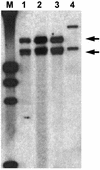16S rRNA sequence diversity in Mycobacterium celatum strains caused by presence of two different copies of 16S rRNA gene
- PMID: 9620415
- PMCID: PMC104915
- DOI: 10.1128/JCM.36.6.1761-1764.1998
16S rRNA sequence diversity in Mycobacterium celatum strains caused by presence of two different copies of 16S rRNA gene
Abstract
Direct sequencing of the 16S rRNA gene (16S rDNA) of Mycobacterium celatum isolates showed ambiguities, suggesting heterogeneity. Cloned 16S rDNA yielded two copies of the gene, which differed by insertion of a thymine at position 214 and by additional mismatches. Restriction fragment length polymorphism analysis confirmed the presence of two copies of 16S rDNA within the bacterial chromosome.
Figures



References
-
- Amann R, Ludwig W, Schleifer K-H. Identification of uncultured bacteria: a challenging task for molecular taxonomists. ASM News. 1994;60:360–365.
-
- Böttger E C, Teske A, Kirschner P, Bost S, Chang H R, Beer V, Hirschel B. Disseminated “Mycobacterium genavense” infection in patients with AIDS. Lancet. 1992;340:76–80. - PubMed
-
- Bull T J, Shanson D C, Archard L C, Yates M D, Hamid M E, Minnikin D E. A new group (type 3) of Mycobacterium celatum isolated from AIDS patients in the London area. Int J Syst Bacteriol. 1995;45:861–862. - PubMed
-
- Butler W R, Connor S P O, Yakrus M A, Smithwick R W, Plikaytis B B, Moss C W, Floyd M M, Woodley C L, Kilburn J O, Vadney F. Mycobacterium celatum sp. nov. Int J Syst Bacteriol. 1993;43:539–548. - PubMed
Publication types
MeSH terms
Substances
Associated data
- Actions
- Actions
LinkOut - more resources
Full Text Sources

